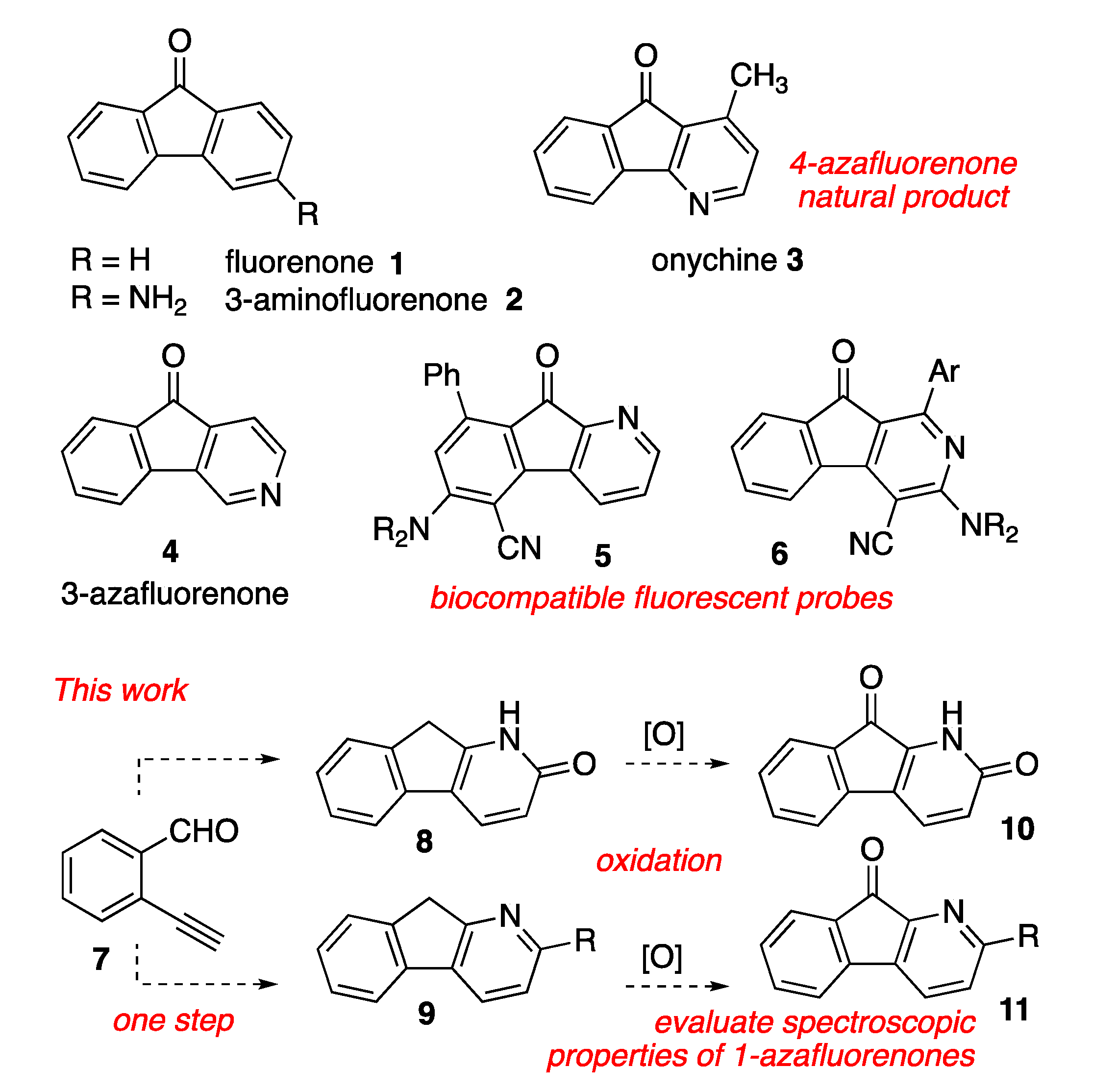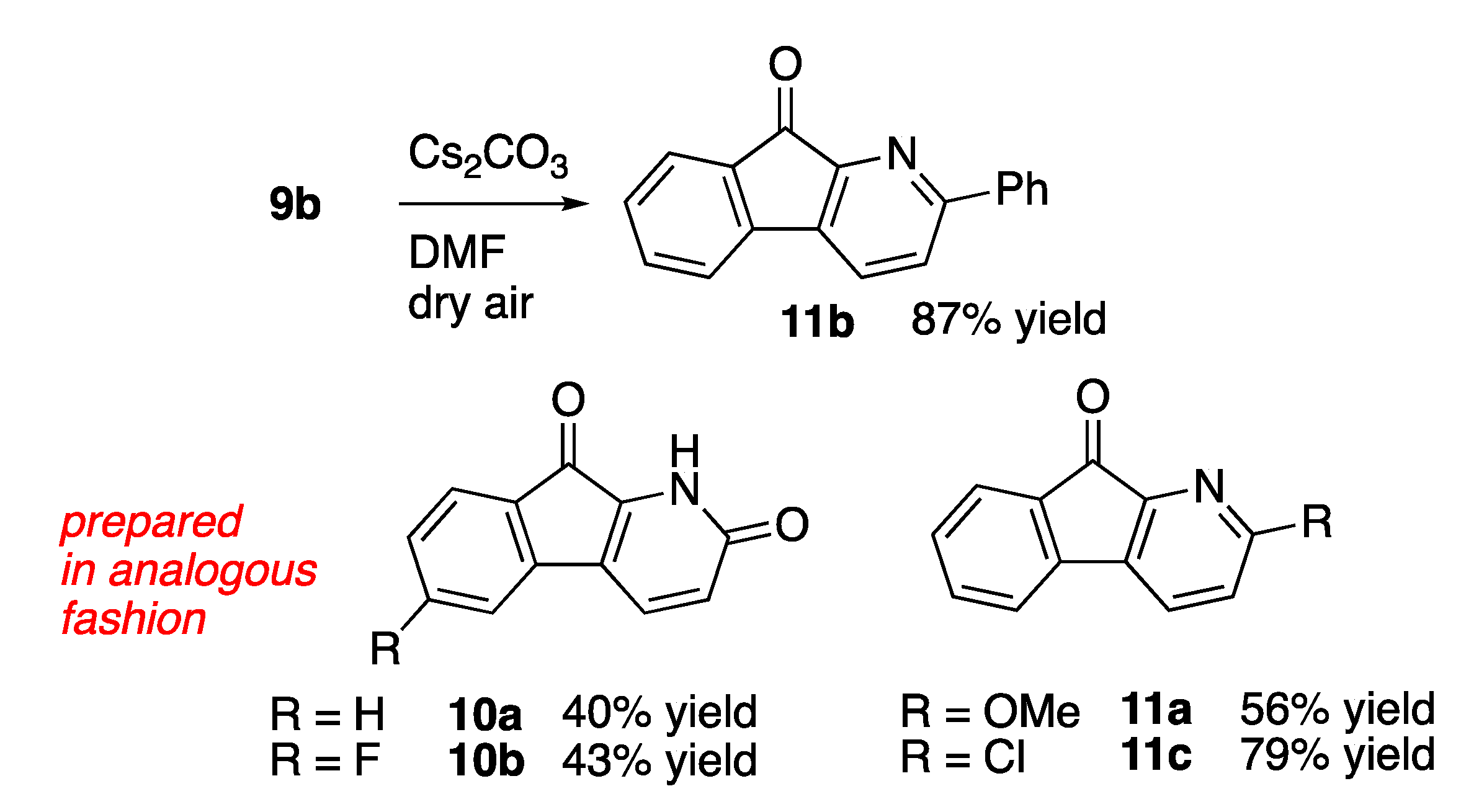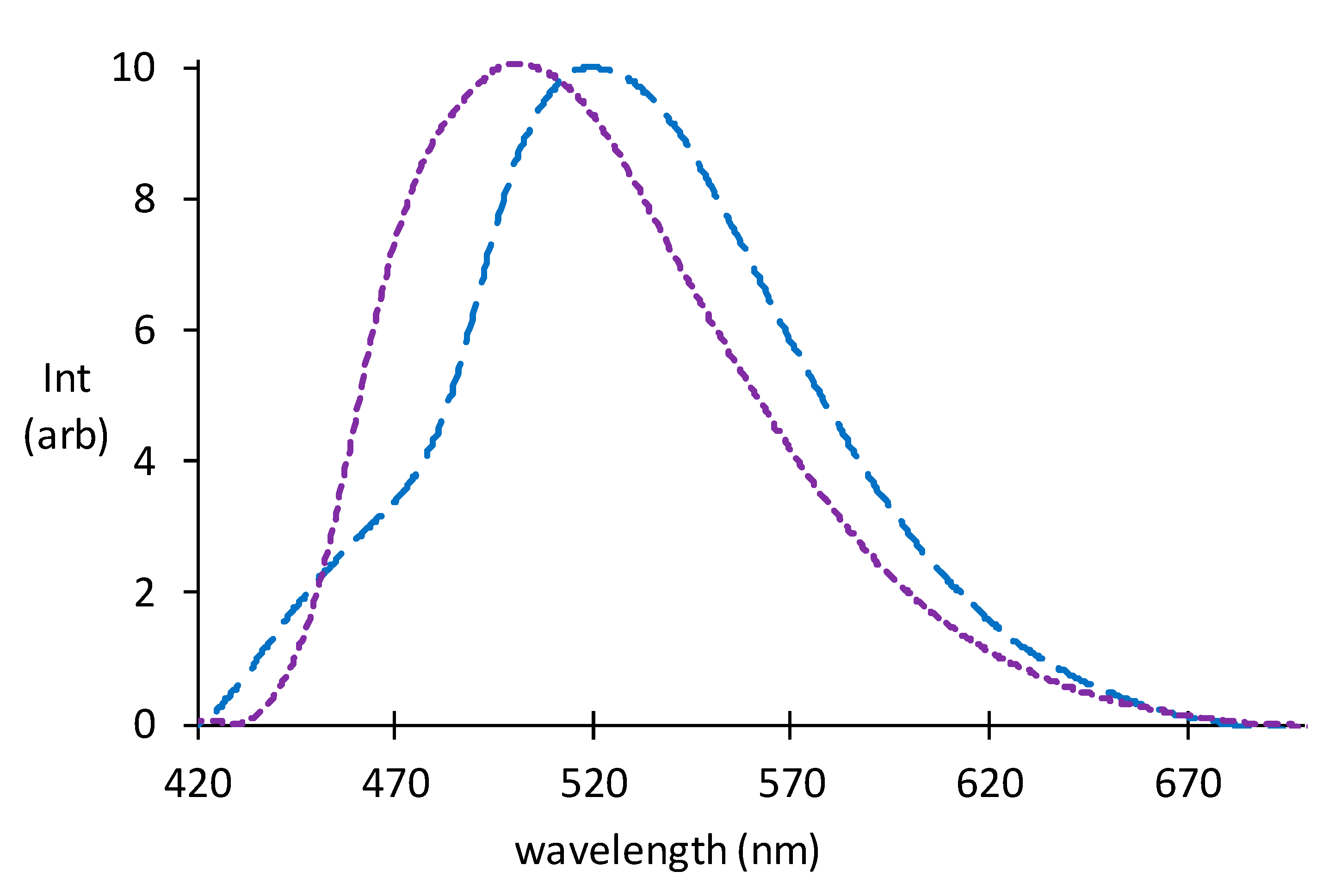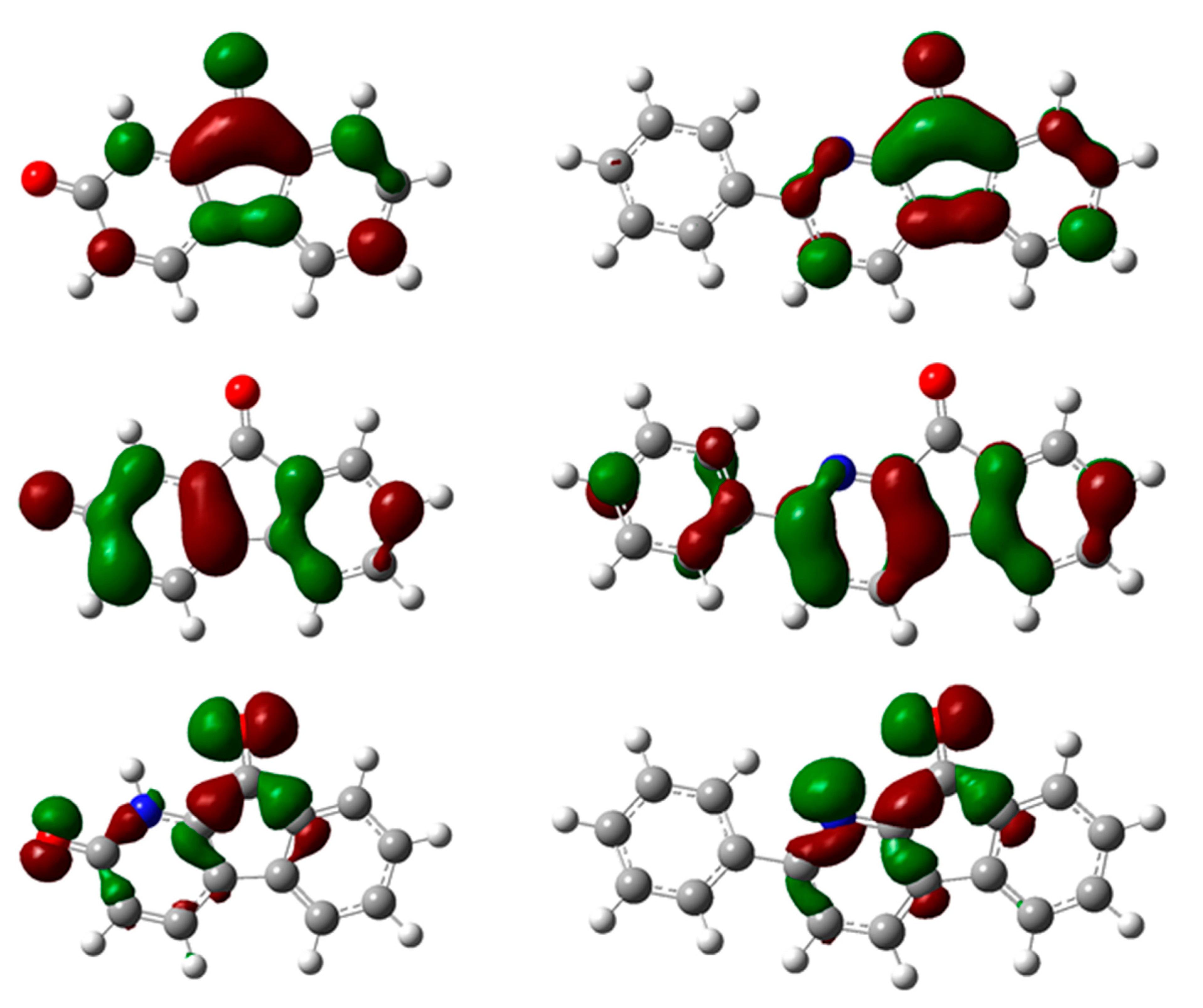Synthesis and Spectrophotometric Analysis of 1-Azafluorenone Derivatives
Abstract
1. Introduction
2. Results and Discussion
2.1. Synthesis


2.2. Optical Properties
2.3. Theoretical Calculations
2.4. Discussion of Fluorescence
3. Materials and Methods
4. Conclusions
Supplementary Materials
Author Contributions
Funding
Acknowledgments
Conflicts of Interest
References
- Herkstroeter, W.G.; Hammond, G.S.; Lamola, A.A. Mechaisms of Photochemical Reactions in Solution. 28. Values of Triplet Excitation energies of Selected Sensitizers. J. Am. Chem. Soc. 1964, 86, 4537–4540. [Google Scholar] [CrossRef]
- Chang, C.W.; Solling, T.I.; Diau, E.W.G. Revisiting the photophysics of 9-fluorenone: Ultrafast time-resolved fluorescence and theoretical studies. Chem. Phys. Lett. 2017, 686, 218–222. [Google Scholar] [CrossRef]
- Jia, M.; Li, Y.; Huang, M.; Kim, K.J.; Liu, Y.; Cao, S. Fluorenone-based molecules for resistive memory devices: Tuning memory behavior by adjusting end groups. Synth. Met. 2020, 226, 116431. [Google Scholar] [CrossRef]
- Xia, J.B.; Zhu, C.; Chen, C. Visible Light-Promoted Metal-Free C-H Activation: Diarylketone-Catalyzed Selective Benzylic Mono-and Difluorination. J. Am. Chem. Soc. 2013, 135, 17494–17500. [Google Scholar] [CrossRef] [PubMed]
- Pitts, C.R.; Bloom, M.S.; Bume, D.D.; Zhang, Q.A.; Lectka, T. Unstrained C-C bond activation and directed fluorination through photocatalytically-generated radical cations. Chem. Sci. 2015, 6, 5225–5229. [Google Scholar] [CrossRef]
- Biczόk, L.; Berces, T.; Inoue, H. Effects of molecular structure and hydrogen bonding on the radiationless deactivation of singlet excited fluorenone derivatives. J. Phys. Chem. 1999, 103, 3837–3842. [Google Scholar] [CrossRef]
- Alty, I.G.; Abelt, C.J. Stereoelectronics of the Hydrogen-Bond-Induced Fluorescence Quenching of 3-Aminofluorenones with Alcohols. J. Phys. Chem. A 2017, 121, 5110–5115. [Google Scholar] [CrossRef]
- De Almeida, M.E.L.; Braz-F, R.; Von Bulow, M.V.; Gottlieb, O.R.; Maia, J.G.S. Onychine, an alkaloid from Onychopetalum amazonicum. Phytochemistry 1976, 15, 1186–1187. [Google Scholar] [CrossRef]
- Pumsalid, K.; Thaisuchat, H.; Loetchutinat, C.; Nuntasaen, N.; Meepowpan, P.; Pompimon, W. A New Azafluorenone from the Roots of Polyalthia cerasoides and its Biological Activity. Nat. Prod. Commun. 2010, 5, 1931–1934. [Google Scholar] [CrossRef]
- Mueller, D.; Davis, R.A.; Duffy, S.; Avery, V.M.; Camp, D.; Quinn, R.J. Antimalarial Activity of Azafluorenone Alkaloids from the Australian Tree Mitrephora diversifolia. J. Nat. Prod. 2009, 72, 1538–1540. [Google Scholar] [CrossRef]
- Shi, Y.B.; Gao, S.H. Recent advances of synthesis of fluorenone and fluorene containing natural products. Tetrahedron 2016, 72, 1717–1735. [Google Scholar] [CrossRef]
- Ye, F.; Tran, C.; Jullien, L.; Le Saux, T.; Haddad, M.; Michelet, V.; Ratovelomanana-Vidal, V. Synthesis of Fluorescent Azafluorenones and Derivatives via a Ruthenium-Catalyzed 2+2+2 Cycloaddition. Org. Lett. 2018, 20, 4950–4953. [Google Scholar] [CrossRef] [PubMed]
- Biczόk, L.; Cser, A.; Nagy, K. Substituent and solvent effects on the photophysical properties of 3-azafluorenone derivatives. J. Photochem. Photobiol. A Chem. 2001, 146, 59–62. [Google Scholar] [CrossRef]
- Biczόk, L. Photophysical properties of 3-azafluorenone. React. Kinet. Catal. Lett. 1997, 61, 57–62. [Google Scholar] [CrossRef]
- Grigg, R.; Mongkolaussavaratana, T.; Pounds, C.A.; Sivagnanam, S. 1,8-Diazafluorenone and related-compounds-a new reagent for the detection of alpha-amino-acids and latent fingerprints. Tetrahedron Lett. 1990, 31, 7215–7218. [Google Scholar] [CrossRef]
- Gao, M.; Su, H.F.; Lin, Y.H.; Ling, X.; Li, S.W.; Qin, A.J.; Tang, B.Z. Photoactivatable aggregation-induced emission probes for lipid droplets-specific live cell imaging. Chem. Sci. 2017, 8, 1763–1768. [Google Scholar] [CrossRef]
- Sharma, A.; Umar, S.; Kar, P.; Singh, K.; Sachdev, M.; Goel, A. A new type of biocompatible fluorescent probe AFN for fixed and live cell imaging of intracellular lipid droplets. Analyst 2016, 141, 137–143. [Google Scholar] [CrossRef]
- Angello, N.H.; Wiley, R.E.; Elmore, T.G.; Perry, R.S.; Scheerer, J.R. Domino Reaction Sequence for the Synthesis of 2.2.2 Diazabicycloalkenes and Base-Promoted Cycloreversion to 2-Pyridone Alkaloids. Org. Lett. 2018, 20, 5203–5207. [Google Scholar] [CrossRef]
- Williamson, J.B.; Smith, E.R.; Scheerer, J.R. A Merged Aldol Condensation, Alkene Isomerization, Cycloaddition/Cycloreversion Sequence Employing Oxazinone Intermediates for the Synthesis of Substituted Pyridines. Synlett 2017, 28, 1170–1172. [Google Scholar] [CrossRef]
- Foresman, J.B.; Frish, A.E. Exploring Chemistry with Electronic Structure Methods, 3rd ed.; Gaussian Inc.: Pittsburg, PA, USA, 2015. [Google Scholar]
- Frisch, M.J.; Trucks, G.W.; Schlegel, H.B.; Scuseria, G.E.; Robb, M.A.; Cheeseman, J.R.; Scalmani, G.; Barone, V.; Petersson, G.A.; Nakatsuji, H.; et al. Gaussian 16; Version 1.1; Gaussian, Inc.: Wallingford, CT, USA, 2016. [Google Scholar]
- Pangborn, A.B.; Giardello, M.A.; Grubbs, R.H.; Rosen, R.K.; Timmers, F.J. Safe and Convenient Procedure for Solvent Purification. Organometallic 1996, 15, 1518–1520. [Google Scholar] [CrossRef]
- Still, W.C.; Kahn, M.; Mitra, A. Rapid chromatographic technique for preparative separations with moderate resolution. J. Org. Chem. 1978, 43, 2923–2925. [Google Scholar] [CrossRef]
Sample Availability: Samples of the compounds are available from the authors. |






| Compound | |||||||
|---|---|---|---|---|---|---|---|
| 11c (Cl) | λmax | 277 | 286 | 301 | 306 | ||
| f × 104 | 4489 | 4 | 4 | 123 | |||
| % n | 0 | 100 | 100 | 58 | |||
| 11b (Ph) | λmax | 288 | 306 | 308 | 316 | 322 | 327 |
| f × 104 | 4995 | 21 | 59 | 423 | 3219 | 907 | |
| % n | 0 | 0 | 0 | 45 | 0 | 52 | |
| 11a (MeO) | λmax | 279 | 279 | 303 | 306 | 427 | |
| f × 104 | 4040 | 3 | 6 | 471 | 1 | ||
| % n | 0 | 100 | 100 | 0 | 100 | ||
| 10a (H) | λmax | 295 | 302 | 324 | 349 | 403 | |
| f × 104 | 3065 | 743 | 4 | 0 | 0 | ||
| % n | 0 | 0 | 0 | 100 | 100 | ||
| 10b (F) | λmax | 291 | 306 | 322 | 347 | 399 | |
| f × 104 | 3042 | 1006 | 194 | 0 | 0 | ||
| % n | 0 | 44 | 41 | 64 | 36 | ||
© 2020 by the authors. Licensee MDPI, Basel, Switzerland. This article is an open access article distributed under the terms and conditions of the Creative Commons Attribution (CC BY) license (http://creativecommons.org/licenses/by/4.0/).
Share and Cite
Angello, N.H.; Wiley, R.E.; Abelt, C.J.; Scheerer, J.R. Synthesis and Spectrophotometric Analysis of 1-Azafluorenone Derivatives. Molecules 2020, 25, 3358. https://doi.org/10.3390/molecules25153358
Angello NH, Wiley RE, Abelt CJ, Scheerer JR. Synthesis and Spectrophotometric Analysis of 1-Azafluorenone Derivatives. Molecules. 2020; 25(15):3358. https://doi.org/10.3390/molecules25153358
Chicago/Turabian StyleAngello, Nicholas H., Robert E. Wiley, Christopher J. Abelt, and Jonathan R. Scheerer. 2020. "Synthesis and Spectrophotometric Analysis of 1-Azafluorenone Derivatives" Molecules 25, no. 15: 3358. https://doi.org/10.3390/molecules25153358
APA StyleAngello, N. H., Wiley, R. E., Abelt, C. J., & Scheerer, J. R. (2020). Synthesis and Spectrophotometric Analysis of 1-Azafluorenone Derivatives. Molecules, 25(15), 3358. https://doi.org/10.3390/molecules25153358






